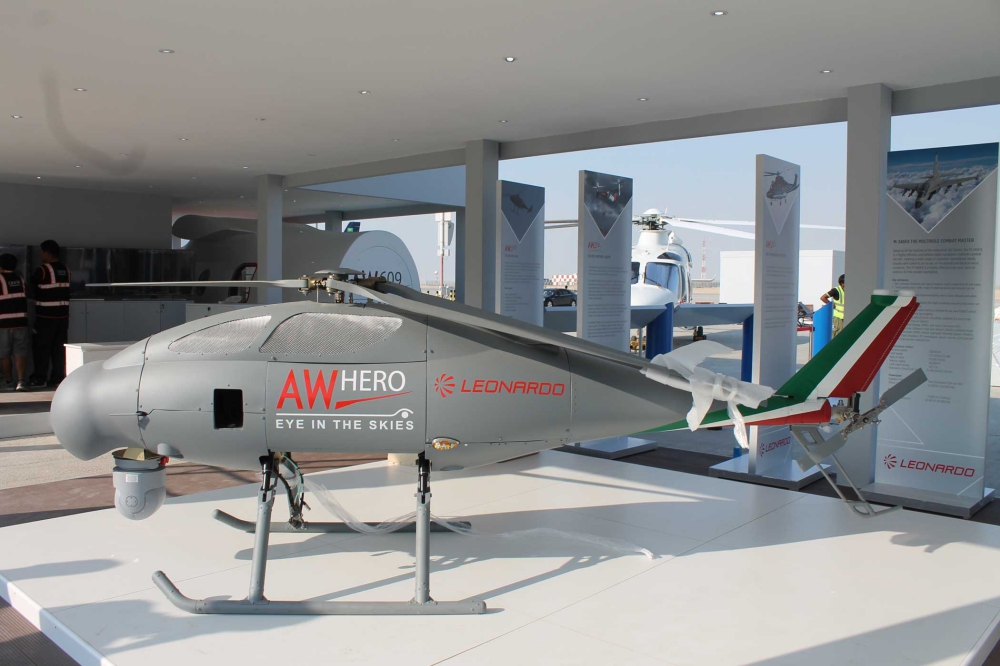Leonardo continues to invest heavily in unmanned helicopter technology, offering the Solo and Hero platforms. No customer has yet bought them, but the Italian and British defense ministries have provided funding for flight trials, and now the company is leading a major research contract on unmanned maritime surveillance for the European Defence Agency (EDA).
Italy is still experiencing substantial illegal cross-Mediterranean migration, so it is appropriate that Italy’s major OEM should lead the EDA’s €35 million (US$41 million) OCEAN2020 project. Leonardo is managing 42 partners from 15 European countries, including aerospace/defense companies, research centers, and ministries of defense. The work will lead to an operational demonstration in the Mediterranean next year during which both the Solo and Hero will fly from various naval vessels. A second demonstration is scheduled for 2020 in the Baltic Sea.
The Solo is based on the SW-4 manned helicopter designed and produced by PZL-Swidnik, the Polish company that Leonardo Helicopters (then AgustaWestland) bought in 2010. That same year, Leonardo began adapting the SW-4 as a rotary-wing unmanned aerial system (R-UAS) for ISR missions and gained its first demonstration contract from the UK Ministry of Defence in 2013. In 2015 the EDA sponsored a trial in Italy that demonstrated “manned-unmanned teaming.”
In October 2016 the Solo returned to the UK to participate in the Unmanned Warrior exercise off the Scottish coast. Meanwhile, the Solo has also flown in Poland on maritime mission trials, which will continue through 2019.
These trials were all flown with a safety pilot on board, and Leonardo has stressed the flexibility of such an optionally piloted vehicle (OPV). However, the Solo made its first flight without a safety pilot in late 2017..
SMALL HERO
The Hero is a much smaller machine that was developed as a pure R-UAS from the outset by another Italian company, Systemi Dinamici—hence its designation, SD-150.
Leonardo first partnered with that company and then acquired total ownership last December. In December 2015 the European Union paid for a demonstration in Italy of how the Hero could be integrated with air traffic control systems in non-segregated airspace. This year, the UK MoD is sponsoring a shipboard demonstration of the Hero.
Although the useful load (fuel plus payload) of the Hero is much smaller than the Solo—85kg (187 pounds) compared with 447kg (986 pounds)—its endurance is potentially greater, at six hours with a 35-kg (77-pound) sensor payload. Both machines can reach 10,000 feet, and Leonardo hopes to extend their ceilings to 16,000 feet. They can each accept JP5 and JP8 fuel, but for shipboard operations, the Hero can fly on jet-A, needing only a software change to the heavy fuel engine.
With the loss rate of similar, competing R-UAS, Leonardo emphasizes the safety features of the Hero. These include a dual-redundant electrical system and a triple-redundant flight control system. The command and control datalink is separate from the payload datalink, including the positions in the ground stations that control them. An independent means of locating the Hero is provided (ADS-B or IFF). The flight-termination system, if ever needed, also operates on a separate datalink. One ground station can control two helicopters and is common between the Hero and the Solo.
The Hero has been exhibited with Leonardo’s own ultra-lightweight Gabbiano synthetic aperture radar; an L3 Wescam MX-8 EO/IR sensor; and the maritime version of IFF, AIS. The Solo can carry larger sensors, but Leonardo notes that there can be advantages to the two helicopters carrying common sensors, if operated in tandem. Other potential payloads—perhaps only for the Solo—include LIDAR, ESM and a maritime-optimized radar.
Ahead of the OCEAN2020 trials, the Hero has flown from an Italian Navy ship. It demonstrated a deck sensor and autopilot modes for landings and takeoffs in up to moderate sea states. Carriage by an NH-90 helicopter was also demonstrated. Leonardo has set a goal of achieving Italian military certification next year.
Leonardo (Outside Exhibit L1) has an ambitious vision for the further development of maritime R-UAS. Anti-submarine warfare, mine warfare, and ship-to-shore resupply could all become possible. The company said that it is creating a core of cross-platform technologies that could be exported to other, larger helicopters that it produces.
The OCEAN2020 trials will also involve fixed-wing manned and unmanned platforms, notably Safran’s Patroller UAS. It will be outfitted with a new mission system, including a maritime surveillance radar, an AIS, and Safran’s Euroflir 410 EO/IR pod that is already fitted on the version of the Patroller that is entering service with the French army.
Photo: Hero unmanned helicopter on display at the Dubai airshow last November – Chris Pocock

